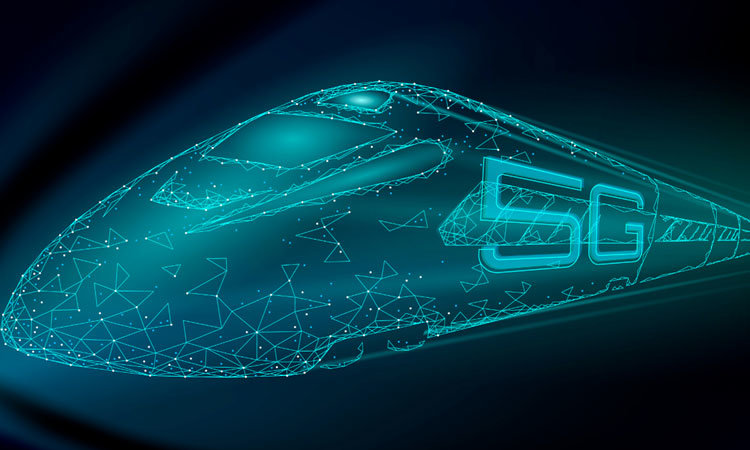railway-usa.com
08
'21
Written on Modified on
Thales News
Welcome to the 5G railway
Discover how new mobile technology could revolutionise your train journey

Lightning-fast gaming and near-instant video downloads are among the attractions of 5G, the latest generation of wireless mobile technology.
5G is fun. But it has serious applications too. These include driverless cars, robotic factories and even remote surgery. This is Industry 4.0 – and railways will be a big part of it.
Why is 5G so important for railways?
5G is a game changer for both main line railways and metros. Two features make it especially attractive:
First, 5G has super-fast reactions. The delay between sending and receiving information can be as little as 1 millisecond. That’s more than 100 times quicker than the blink of an eye (and 200 times faster than 4G). 5G is also highly dependable – reliability is 99.999%.
Second, 5G moves massive amounts of data extremely quickly. The maximum data rate is 10Gbps. Or put another way, you could download your favourite movie (in DVD quality) in less than half a second. 5G is between ten and 100 times faster than current 4G technology.
Until now, performance of this sort could only be achieved using wired networks – a big drawback if you want to exchange data quickly with a moving object, like a train. But with 5G, you can connect anything, anywhere. And that has big implications for railways.
The Internet of Smart Trains
5G doesn’t just connect trains to networks, it makes trains part of the network. This makes it a catalyst for railway digitalisation, paving the way for a number of exciting new applications – including autonomous trains.
- Smart signalling
Railway signalling will leapfrog thanks to a new ability to process massive amounts of data in near real time.
Accurate 5G positioning will enable closer spacing between trains, so more trains can travel over existing tracks. Trains will even be able to “talk” to each other using T2T (train-to-train) communications. This will enable virtual coupling, so two trains can move along together as if they were physically coupled.
Trains will also be able to talk to their surroundings, thanks to T2I (train-to-infrastructure) communications. Coupling T2I with edge computing accelerates decision making – a vital ingredient in the evolution of autonomous train operation.
- Smooth operations
Massive 5G-enabled Internet of Things (IoT) deployments will provide new ways to monitor trains and infrastructure.
Benefits include better traffic forecasts and an ability to orchestrate train movements right across the network, eliminating bottlenecks. Operators will be able to monitor power consumption easily for greener, low-carbon journeys. This is an increasing need as businesses – and nations – aim for net zero emissions. Meanwhile, wear-and-tear monitoring will accelerate the shift to predictive maintenance – keeping trains out of the depot and on the track for longer.
- Happier passengers
5G promises to transform the passenger experience with comfortable, seamless journeys and new services.
Passengers love broadband. Thanks to 5G, onboard connectivity will be faster and more reliable than ever. But 5G will also make it possible to offer new ticketing products, helping passengers to get the best deal and enabling personalised marketing campaigns targeting millions of customers. It can even monitor queues at the ticket office and help passengers to avoid crowds on platforms and trains.
Making rail communications as easy as 1-2-3
5G promises to open up a whole new world of applications and services. It also solves a number of pain points that operators have struggled with for years.
- Demand for new services
conventional radio systems, such as Wi-Fi, TETRA and GSM-R, can no longer keep pace with the growing ambitions of rail operators and passengers. 5G is a one-stop shop, with capacity to support use cases now and in the future – all using a single radio standard.
- Lifecycle discrepancies
There is a big disconnect between the lifespan of a train (which can last for 40 years or more) and the radio technology on which it depends (which is typically obsolescent within a decade). Thanks to smart onboard systems, operators can mix and match radio systems, and seamlessly migrate from 5G to 6G when the time comes.
- High equipment costs
Only a small number of vendors are able to address railway requirements, limiting competition. Meanwhile, the need for transport-specific products is responsible for expensive low-scale production. 5G solves these problems by reducing the need for costly proprietary equipment.
Our vision for the 5G railway
5G is a revolutionary opportunity for rail. It will not only improve performance, but also transform the architecture of networks and telecommunications.
Thales provides an end-to-end modular architecture that allows you to migrate smoothly from legacy technologies to future networks. Our offer includes centralised network orchestration, adaptive onboard communication systems and secure end-to-end IoT architecture. Everything is Cybersecured by Design, safeguarding your operations and boosting performance for years to come.
www.thalesgroup.com/en/worldwide/transport/news/welcome-5g-railway

